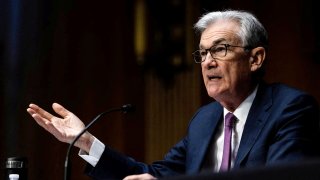
- The Fed is expected to start raising rates as soon as March, but what the market is more worried about is an aggressive rate hiking cycle.
- The balance sheet unwind that the Federal Reserve has planned as part of its hawkish tilt amid inflation could add more volatility.
The Federal Reserve is going to raise rates, and based on the latest inflation reading this week, the central bank is likely to start its rate hike cycle in March. The Fed has telegraphed the rate hikes, but the market remains on edge because the hawkish turn from Fed Chair Jerome Powell has occurred quickly and goes beyond higher rates to an unwind of the Fed's massive balance sheet.
It's the pace of the tightening cycle that remains an unknown, says Priya Misra, global head of rates strategy at TD Securities, and that will contribute to volatility this year.
"The Fed has been communicating ... but where the uncertainty comes in is the pace, the end point, the sense of urgency," Misra said.
Here are the rates expert's top concerns:
1. The Fed stance on inflation and monetary policy has shifted abruptly, and it could happen again.
Money Report
Misra said the Fed has gone from "this might be transitory" on inflation to "let's start hiking the moment we end tapering."
A few months ago, the two types of tightening action were not being communicated as completely aligned by the Fed.
Feeling out of the loop? We'll catch you up on the Chicago news you need to know. Sign up for the weekly Chicago Catch-Up newsletter here.
2. The balance sheet unwind adds another layer of market volatility.
The market saw the rate hikes coming, and knew the taper was on deck, but was surprised by the December FOMC meeting minutes and the extensive talk about the balance sheet unwind occurring sooner rather than later.
"I am a little nervous about that large balance sheet runoff," Misra said.
The Fed's balance sheet is roughly $9 trillion and no one knows exactly where that normalizes at a lower level and there is little experience from the past with Fed balance sheet unwinds and market impact.
3. Three rate hikes, not four in 2022, but the balance sheet matters more
Goldman Sachs is forecasting four rate hikes this year while the consensus forecast is three, but Misra says even with three rate hikes there is reason to worry.
"We've got three rate hikes and a balance sheet runoff, which is a pretty strong form of tightening. They have that tool and we think they will use it near year-end as a substitute for a hike," she said, referring to a potential fourth hike.
Misra says three rate hikes will be sufficient in 2022 because fiscal support is dropping and another round is not expected, and that will lead to consumer spending slowing down, as well as lower inflation. "Three is enough this year. ... Start talking about four rate hikes and the balance sheet runoff and it will be a drag on the economy. So four or higher is too much, unless we get more fiscal support for the consumer," she said.
4. Above 2.5% on 10-year is 'danger zone.'
Misra said the market will be keyed on the 10-year Treasury and if it gets above 2.5% that will impact risk assets.
She does not expect that threshold to be reached this year. "We think 2.25% by year-end. ... Get above 2.5%, anything above 2.25% and 2.5%, and it starts to become the danger zone," Misra said.
Even if that level isn't reached before 2023, there is still the big open question into next year: What will be the end point of the rate hiking cycle? "It hasn't been priced in," she said. "What about the next year? The end point of the tightening cycle that needs to get priced in."






